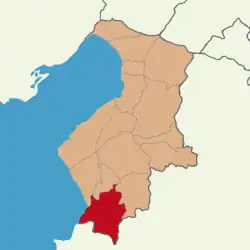Yayladağı
Yayladağı (pronounced [ˈjajɫaˈdaɯ]), formerly Ordu (Arabic: اوردو, romanized: ʾŪrdū; Western Armenian: Օրտու, romanized: Ōrdu), is a municipality and district of Hatay Province, Turkey.[2] Its area is 445 km2,[3] and its population is 36,803 (2022).[1] It is on the border with Syria, 51 km (32 mi) south of the city of Antakya.
Yayladağı | |
|---|---|
 | |
 Map showing Yayladağı District in Hatay Province | |
 Yayladağı Location in Turkey | |
| Coordinates: 35°54′09″N 36°03′38″E | |
| Country | Turkey |
| Province | Hatay |
| Government | |
| • Mayor | Mehmet Yalçın (AKP) |
| Area | 445 km2 (172 sq mi) |
| Elevation | 450 m (1,480 ft) |
| Population (2022)[1] | 36,803 |
| • Density | 83/km2 (210/sq mi) |
| Time zone | TRT (UTC+3) |
| Postal code | 31550 |
| Area code | 0326 |
| Website | www |
Yayladağı was heavily damaged by powerful earthquakes in February 2023 and subsequent aftershocks.[4]
Demographics
19th-century German traveler Martin Hartmann noted that the town was made up of 150 Muslim and 30 Greek households. He further listed 29 additional settlements in the Ottoman nahiyah of Urdu: 18 settlements were Sunni Muslim (totaling to 495 houses), 14 of which were Turkish[5] (400 houses). 1 settlement was Alawite (20 houses). 2 settlements were Armenian, one being Kessab (200 houses) and the other a village (15 houses). Hartmann didn't include any information on the remaining 7 settlements.[6]
After the Syrian Civil War broke out, nearly 2,000 Syrian Turkmen moved here from Turkmen Mountain.[7]
Geography
Today, Yayladağı itself is a small town, providing the district with a health centre, high schools and other basics.
This is a mountainous district with a typical Mediterranean climate of hot, dry summers and warm, wet winters, but being inland and high up, Yayladağı is cooler than most of Hatay, even seeing snow on the mountain peaks in winter. The main source of income is agriculture, 96 km2 (37 sq mi) of the land (small valleys and plateau in the mountains) is cultivated with olives, tobacco, vegetables, grains and other crops, the remainder is forest and mountain. The mountainsides are covered with pine, sandalwood and rough oak, or else shrubs including bay, thyme and oleander. Animals, especially goats, are grazed on the hillsides.
Yayladağı has a border crossing into Syria, and the village of Topraktutan, Turkey's southernmost point. The state road D.825 (European route E91) connects the border checkpoint with Antakya.
Composition
There are 47 neighbourhoods in Yayladağı District:[8]
- Arslanyazı
- Aşağıpulluyazı
- Aydınbahçe
- Ayışığı
- Bezge
- Bozlu
- Çabala
- Çakıköy
- Çaksına
- Çamaltı
- Çandır
- Çatbaşı
- Çayır
- Denizgören
- Dusduru
- Eğerci
- Görentaş
- Gözlüce
- Gürışık
- Güveççi
- Güzelyurt
- Hisarcık
- Karacurun
- Karaköse
- Kışlak
- Kızılçat
- Kösrelik
- Kulaç
- Kurtuluş
- Leylekli
- Olgunlar
- Şakşak
- Sebenoba
- Şenköy
- Sungur
- Sürütme
- Turfanda
- Tutlubahçe
- Üçırmak
- Uluyol
- Yalaz
- Yayıkdamlar
- Yeniceköy
- Yeşiltepe
- Yoncakaya
- Yukarıokçular
- Yukarıpulluyazı
References
- "Address-based population registration system (ADNKS) results dated 31 December 2022, Favorite Reports" (XLS). TÜİK. Retrieved 19 September 2023.
- Büyükşehir İlçe Belediyesi, Turkey Civil Administration Departments Inventory. Retrieved 19 September 2023.
- "İl ve İlçe Yüz ölçümleri". General Directorate of Mapping. Retrieved 19 September 2023.
- "Hatay'da ağır yıkımın bilançosu..." [The result of the heavy destruction in Hatay...] (in Turkish). Iskenderun.org. 2023-04-08.
- Hartmann, Martin (1894). Das liwa Haleb (Aleppo) und ein Teil des Liwa Dschebel Bereket. Berlin: W. Pormetter. p. 71. Retrieved 30 November 2022.
- Hartmann, Martin (1891). "Das Liwa el-Ladkije und die Nahije Urdu (Schluss.)". Zeitschrift des Deutschen Palästina-Vereins. JSTOR. 14: 243. JSTOR 27928611. Retrieved 4 December 2022.
- Bayırbucak Türkmenleri Yayladağı'ndaki kampa alınıyor
- Mahalle, Turkey Civil Administration Departments Inventory. Retrieved 19 September 2023.
